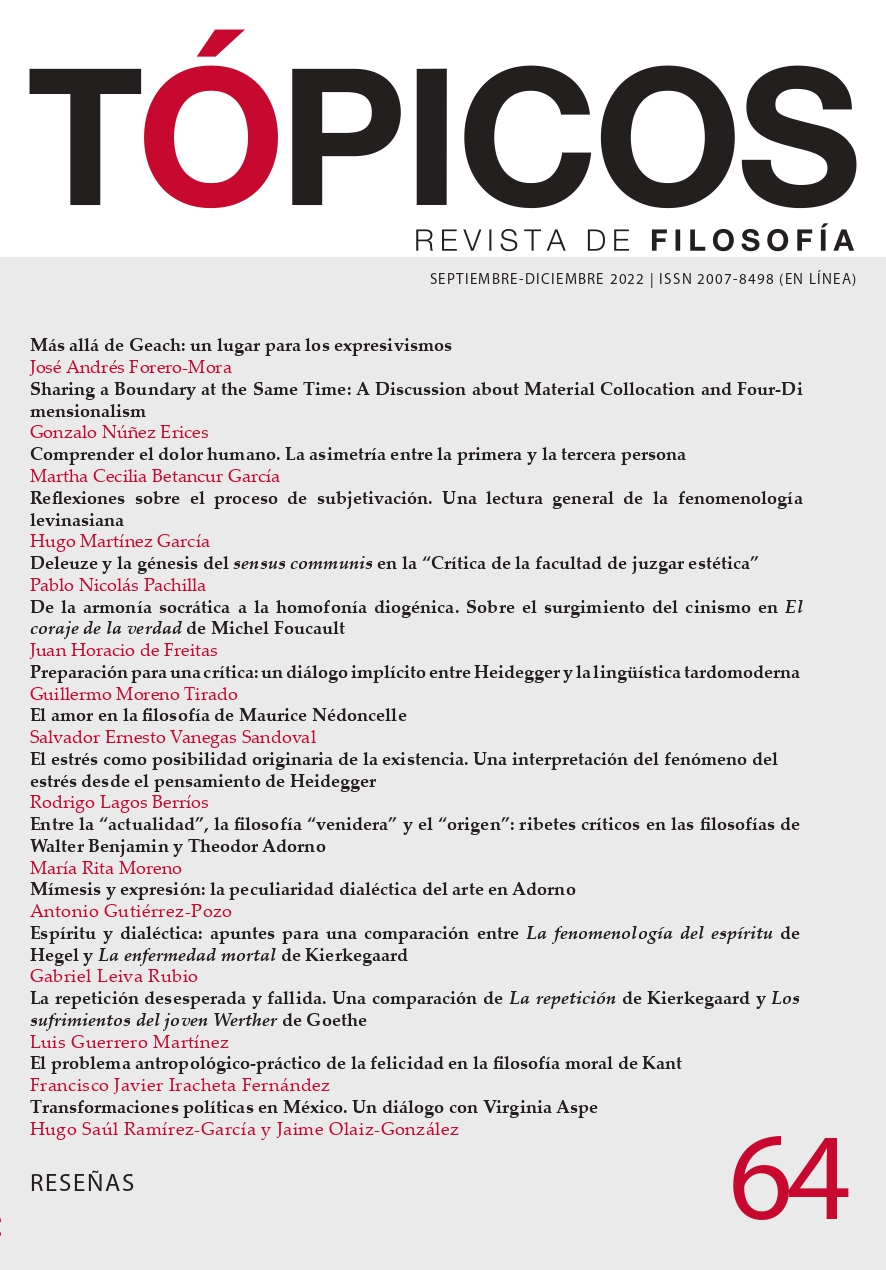Publicado 2022-08-13
Palabras clave
- asimetría entre primera y tercera persona,
- expresiones de dolor,
- postura egocéntrica,
- observación interpretante,
- comprensión
Derechos de autor 2022 Tópicos, Revista de Filosofía

Esta obra está bajo una licencia internacional Creative Commons Atribución-NoComercial-SinDerivadas 4.0.
Cómo citar
Resumen
Uno de los aportes más significativos de la aplicación del método analítico en la obra tardía de Wittgenstein consiste en la diferenciación de la estructura gramatical, semántica y pragmática de los enunciados de primera y tercera persona que expresan los sentimientos y las vivencias del ser humano. Su análisis intenta demostrar la diferencia en significado y comprensión entre los enunciados de la forma “estoy deprimido” y “Arthur está deprimido”. Este artículo está orientado a mostrar las implicaciones teóricas del estudio de Wittgenstein, que permite validar y legitimar las especificidades de la psiquiatría y la psicología en cuanto ciencias de distinto tipo a las ciencias naturales, que se configuran en medio de juegos de lenguaje distintos, y las cuales requieren de la observación interpretante y la comprensión de las expresiones significativas de la vida afectiva del ser humano, como son el lenguaje, las acciones y las figuras simbólicas. Con este análisis, Wittgenstein abre un canal de comunicación entre la filosofía analítica y la hermenéutica para los estudios del ser humano.
Referencias
- Betancur García, M. C. (2006). Metáfora y ver como. La creación de sentido de la metáfora. Universidad de Caldas.
- Budd, M. (1989). Wittgenstein’s Philosophy of Psychology. Routledge.
- Chisholm, R. (1994). Act, Content and the Duck-Rabbit. En J. V. Canfield y S. G. Shanker (eds.), Wittgenstein’s Intentions. (pp. 87-103). Garland Publishing.
- Churchland, P. (1994). The Engine of Reason, the Seat of the Soul. McGraw Hill.
- Cornman, J. W., Lehrer, K. y Pappas, G. S. (2006). Introducción a los problemas y argumentos filosóficos. G. Castillo Espejel, E. Corral Peña y C. Martínez Urrea (trads.). UNAM.
- Crick, F. (2003). La búsqueda científica del alma. F. Páez de la Cadena Tortosa (trad.). Random House Mondadori.
- Descartes, R. (1980). Obras escogidas. E. de Olaso y T. Zwanck (trads.). Charcas.
- Edelman, G. (2004). Wider than the Sky: The Phenomenal Gift of Consciousness. Yale University Press.
- Gergen, K. (1996). Realidades y relaciones. Aproximaciones a la construcción social. F. Meler Ortí (trad.). Paidós.
- Gil de Pareja, J. L. (1992). La filosofía de la psicología de Wittgenstein. PPU.
- Hacker, J. (1993). Wittgenstein. Meaning and Mind. Blackwell.
- Hadot, P. (2004). Wittgenstein y los límites del lenguaje. M. Arranz (trad.). Pre-textos.
- Kenny, A. (1995). Wittgenstein. A. Deaño (trad.). Alianza.
- Kenny, A. (2000). Metafísica de la mente. F. Rodríguez Consuegra (trad.). Paidós.
- Krebs, V. (2003). El problema de la subjetividad y la importancia de ver aspectos en: A. Flórez, M. Holguín y R. Meléndez (eds.), Del espejo a las herramientas. Ensayos sobre el pensamiento de Wittgenstein. (pp. 261-288). Universidad Nacional de Colombia-Pontificia Universidad Javeriana-Siglo del Hombre Editores.
- Locke, J. (1973). Ensayo sobre el entendimiento humano. E. O’Gorman (trad.). FCE.
- Moreno, K. (2011). Wittgenstein y la naturalización de la mente. Tesis Psicológica, 6(1), 183-200.
- Mulhall, S. (1990). On Being in the World. Wittgenstein and Heidegger on Seeing Aspects. Routledge.
- Neurath, O. (1993). Proposiciones protocolares. En A. J. Ayer (ed.), El positivismo lógico. (pp. 205-212). L. Aldama, U. Frisch, C. N. Molina, F. M. Torner y R. Ruiz Harrel (trads.). FCE.
- Olvera, C. (2008). Wittgenstein y las objeciones a la primera persona. Caleidoscopio. Revista Semestral de Ciencias Sociales y Humanidades, 12(24), 49–86.
- Penrose, R. (1994). Shadows of the Mind. Oxford University Press.
- Pérez. M. A. (2006). Mente y relevancia. Universitas Psychologica, 5(2), 385-396.
- Ryle, G. (1975). El concepto de lo mental. E. Rabossi (trad.). Paidós.
- Phillips, T. y Scott, S. (2019). Joker. [Guasón]. [Película]. DC Films-Warner Bros. Pictures-Village Roadshow Pictures.
- Ricœur, P. (2000). Historia y narratividad. G. Aranzueque Sahuquillo (trad.). Paidós.
- Ricœur, P. (2006). Sí mismo como otro. A. Neira Calvo (trad.). Siglo XXI.
- Sánchez, H. (2016). Movimientos sociolingüísticos en las conversaciones terapéuticas. Universidad de Caldas.
- Tortosa, F. y Civera, C. (2006). Historia de la psicología. McGraw Hill-Interamericana.
- Vicente Arregui, J. (1984). Acción y sentido en Wittgenstein. EUNSA.
- Wittgenstein, L. (1988). [II. FF.]. Investigaciones filosóficas. A. García Suárez y U. Moulines (trads.). Crítica.
- Wittgenstein, L. (2006). [OFP]. Observaciones sobre filosofía de la psicología. Dos volúmenes. L. F. Segura y C. Pereda (trads.). UNAM.
- Wittgenstein, L. (2008). Sobre la certeza. J. L. Prades y V. Raga (trads.). Gedisa.





